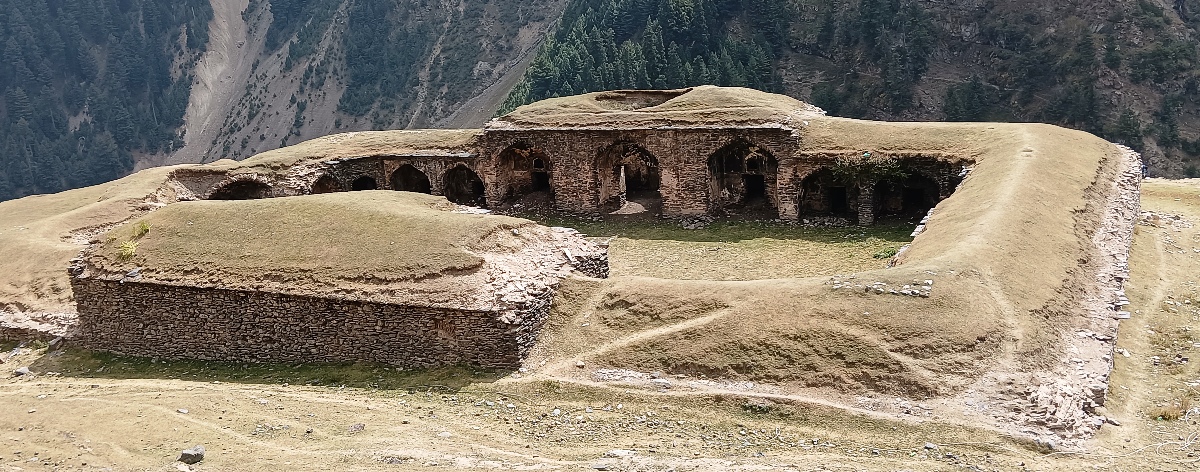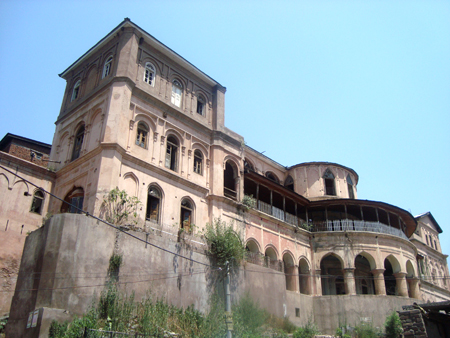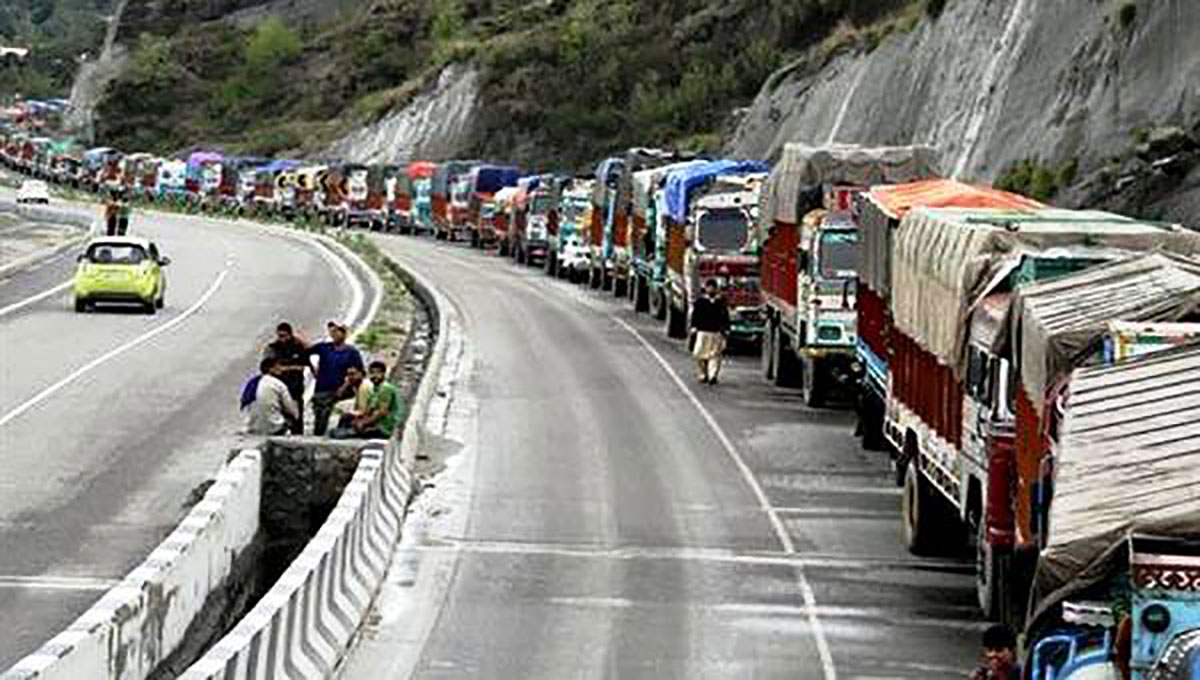Even before the Mughal Road is completed, thousands take the route to cross Pir Panchal. Reopening it has triggered changes in the region that will be felt in Srinagar soon. The historic battleground of Poonch-Rajouri is fast becoming J&K’s new political amphitheater. Kashmir Life examines the impact.
![New Political Amphitheater New Political Amphitheater[Photo:Bilal Bahadur]](https://kashmirlife.net/wp-content/uploads/2012/09/cover-issue-19-vol-4.jpg)
By the middle of May this year, almost every second person in Poonch and Rajouri was concerned over the continued closure of the Mughal Road – an upcoming highway connecting Shopian with the Pir Panchal region slated to be through formally in March 2013.
Passenger carriers, private cars and small trucks had started plying on the under construction highway much earlier and continued till early December when the season’s first snowfall closed Pir Ki Galli, the highest mountain pass separating Bafliaz from Shopian.
“For the last few years, it is the main summer movement route to Kashmir for [cattle] herds and cars and that is why there was concern,” said Mehmood Farooq who is affiliated with transport business in Surnakote. “It is open now and the vehicles using the road, especially because of the Wangat Urs, are in hundreds. Even the big buses are plying because the road is much better now.”
A congregation of some 250 writers, poets, lawmakers, reporters and businessmen and former officials at Poonch was the first major event in the region after the road came up. The delegates traveled via the Mughal Road for the Kashmiri conference organised annually by Adbi Markaz Kamraz.
For many the event was historic and emotional because it was the first formal effort of Kashmiri civil society to rediscover Kashmir on the other side of the mountains. “Our caravan was received so emotionally that we thought as if we were late in creating the history,” said Shujaat Bukhari, the journalist who is the Markaz’s main mover and shaker. “It was history as the participants debated the main theme of the conference Kasheer Chhene Kahai Ghare (Kashmir is not just eleven families) for four hours” The theme is actually a Kashmiri adage in response to continued efforts of dividing and subdividing Kashmir and restricting it to the valley floor bed. Many think, the official rise of the concept of ‘Kashmiriyat’ was part of the same divisive process.
The literary conference, that some people think should have waited till the formal opening of the road, would make “passages” easy at a place living on a caste fault line, and has already proved a huge initiator of events. While a debate over Sachar Committee Report on minorities is currently taking place in Rajouri, a major exercise is underway to organise a congress on the Gujjar language.
Gradually, the dependence of Rajouri and Poonch on the Mughal Road is increasing and has started making a difference. “We get fresh vegetables at almost half the rates now,” said Fareed Ahmad, a resident of Poonch. “We would get apples at around Rs 80 a kilogram and now we get it at less than Rs 20.”
Last year, residents say, people started consuming so much of apple that for a few months “it was part of the breakfast, lunch and dinner.”
People on either side of the Pir Panchal range have been forging matrimonial alliance since ages. In fact, most of the localities in Pir Panchal belt have Kashmiri speaking, Kangri-using, salt-tea drinking populations flaunting surnames common in the Vale. The new motorable road has increased the magnitude of such alliances. “I am told some Kashmiri businessmen have started renting shops and spaces on the other side because markets are integrating,” a north Kashmir based political activist said. “The going is getting great.”
From Jammu, the provincial administrative headquarter, the region is far away – Poonch at 240 kms and Rajouri 154 kms. Jammu has also been the nearest major market. For the twin border districts, Kashmir has remained far away and difficult to reach. If not approached from the mountains, it is a two-day travel, first to Jammu and then another 300 kms to Srinagar. ‘The Mughal Road has brought the ‘remote’ Vale much closer’.
Connecting Poonch with Srinagar through Bafliaz and Shopian has been a dream of the people on both sides of the mountain range, and a real need too. The state cabinet first approved execution of this road project on March 8, 1985 (cabinet decision 148), years after the process was initiated in 1977 by executing certain works in piecemeal. The J&K State Projects Construction Corporation (JKPCC) did earthwork on 30 kms from Shopian side and around 15 kms from Poonch side. By 1989, the project was handed over to the Border Roads Organization (BRO). The eruption of militancy sent the project packing.
In 1997, the project was revived to make a case before the Prime Minister for fifty percent funding. A Government of India undertaking, RITES was hired for a fresh feasibility study that estimated the road to cost Rs 159 crore. By the time the project was restarted in 2004, the government had booked Rs13.53 crore on laying 59 kms of road of which 18 kms were black-topped, 26 kms were fair-weathered and on remaining 12 kms earth work was done.
And on January 22, 2004, Congress’s R&B Minister Gulchain Singh Charak made a last ditch effort to prevent the project from going ahead. He went to the cabinet seeking approval for “winding up of the project”.
“The road has always been a matter of controversy, with the Defence Ministry and the security agencies suggesting its complete scrapping,” Charak reasoned in his four-page memo to the cabinet. “The constant refrain has been that it would hamper the national interests and would facilitate the quick movements of anti-national elements. Vast uninhabited hilly stretches could also grow into new heavens for the terrorists, they felt.”The minister said the project was not required because the Jammu-Baramulla railway line would be operational by August 2007. Foreseeing costs jump over Rs 200 crore, he thought the road was very expensive.
But his Chief Minister, Mufti Mohammad Sayeed overruled him and the cabinet approved the road. It was a historic move. Many years later, Kashmir’s most controversial governor, General (retd) S K Sinha termed the road an ‘Islamic corridor’. He listed it as one of the factors that made Mufti Sayeed an anti-national for him.

Tenders were floated and HCC was awarded the contract to build the road. Work started in March 2006. Though it would be formally open in March 2013, but the road has been in use during summers since 2009. The project that has already booked Rs 529.87 Crores out of the total cost of Rs 639.87 Crore is facing some delays. Comptroller and Auditor General (CAG) has pointed out that the state government surrendered the project funds for two years. Work on the project was hampered in wake of serious civil strife in 2008 and 2010 and again in the summer of 2009 when life in Shopian came to a standstill after alleged rape and murder of two sisters-in-law in the town.
The Mughal Road has already started making a difference on the ground, physically, emotionally and politically. Even laymen credit Mufti Sayeed for the project which was initiated and abandoned during different governments of National Conference (NC). In 2002, the PDP did not exist in Pir Panchal Range. In 2008, it bagged two of the seven assembly seats and lost one by a whisker. The 84288 votes it polled were more than half of what the NC bagged. Just one developmental intervention made it as strong in the region as the Congress party (two seats) was. Three assembly seats in the region are with the NC. In 2009 Lok Sabha polls, the PDP improved its tally to 93730 votes and finished third as the coalition candidate (Congress) won with BJP playing second fiddle.
The two Kashmir-centric parties are battling it out at ground zero in a way in which they are not engaged even in the Kashmir valley itself. “She (Mehbooba Mufti) might have visited Poonch-Rajouri as many as 18 times in last eight months,” admits a NC activist in Poonch. “Finally, Chief Minister was gracious enough to spend a number of days in the area, visiting many places. We will not permit them (PDP) to get the credit.”
Even a PDP leader admitted: “Everybody in the region will credit Mufti for the road but it is not necessary that it will reflect in a wave for the party because the region is strongly rooted in caste.”
But, can a less than 100 km mountain road make such a big difference? Apparently, it should not but the natives suggest revisiting to history. Unlike the Jhelum Valley Road (Srinagar-Uri-Muzaffarabad) that connected Kashmir with the rest of the world and paving way for import of ideas and knowledge to Kashmir, the so called Mughal Road was always used by invaders to suppress and annex Kashmir.
It all started well before Kashmir’s transition to Islam and the most referred invader was Zalchu Khan, a Mangol warlord and a descendent of Halaku. He invaded Kashmir in the summer of 1323 AD when apparently the last Hindu king Sahadeva was ruling the valley. Not interested in retaining Kashmir, Khan devastated it, unseated the king and by the end of autumn left the valley only to be trapped in the snowstorm on the mountains. He perished with his army. Rinchan, a Tibetan prince took over before converting to Islam to become the first Muslim ruler of Kashmir in 1324 AD for two years before vanishing without a trace.
“It is strange but a fact that almost everybody who made Kashmir suffer came from this route,” said Naem Akhter, former bureaucrat, columnist and spokesman of the PDP. “Mughals, Sikhs, Afghans, almost everybody came from this route and seized the throne in Kashmir.”
The conquerors’ using this route led to closer relations between Poonch and Kashmir valley. Historians say that kings in Kashmir would routinely receive and return gifts including women. The Raja of Rajouri sent a damsel to the harem of Zainulabideen in Kashmir, who later built Rajouri Kadal.
But there are other stories as well. Khush Dev Mani, a former officer, is perhaps one of the best known writers from the region. “Poonch has remained not only the gateway of Kashmir but it has remained its shield as well,” says Mani.
“It all started during the reign if Laltadatiya when he converted Poonch into a military garrison with the sole motive that battles aimed at seizing Kashmir must be fought on this side of the foothills and since then the region has been home to the marshal races.”

As a prelude to partition of the Indian subcontinent, the region went through the most painful period of its history. Soldiering was a main occupation for the marshal race and a number of them worked for the British and fought their wars. At Poonch’s war memorial, two small marble plaques sent by the British Queen acknowledging their contribution, is dwarfed by the massive structure listing countless Indian army soldiers who died retaining the region during the last 60 years. “From this tehsil (Hevli) 2798 men went to the Great War (1914-1919), of these 33 gave up their lives,” reads one plaque. The other says there were 12455 soldiers from the entire Poonch belt of whom 521 died in the war.
When the survivors returned home, they felt choked. “They (soldiers) were exposed to much sophisticated systems in Europe and elsewhere and were dissatisfied with the governance at home,” Mani said. “As they were at good terms with Britons, they would often meet their local General and discuss their problems with him.” These discussions led the General meet Hari Singh and suggest an interaction with the war veterans. This, Mani said, was a better option (for Hari Singh) than receiving a formal order from the Viceroy.
A meeting was scheduled between the state’s monarch Hari Singh and the soldiers in the premises of a school in Rawlakot on April 24, 1947. “Soldiers had made elaborate arrangements,” said Mani. “There were around 25000 people and the soldiers had decided to salute their king and organize a ceremonial march past.” This was misunderstood by Hari Singh’s local Wazir Bhim Sen who forewarned him that the soldiers may be preparing to make an attempt on his life. “Perceiving threat to his life, Hari Singh fled from the scene in the dead of night” Mani says.
Feeling betrayed, the soldiers decided to fight the monarchy. Unrest started and by June 1947, Dogras had sent a brigade of army to suppress the agitation and the soldiers committed grave human rights violations – massacred people, hanged the local leaders and set afire vast areas. Local leaders fought with valour and successfully liberated their area. “This was the starting point for the Kashmir movement,” asserts Mani.
Those were the most turbulent times in the region. Unlike rest of the Kashmir and Jammu that stabilised by the end of 1947, Poonch was still in trouble. Most of it was taken over by the tribals and the war that impacted the demography of the region with most of the majority Muslim population actually going towards Bagh and Rawlakot and the Hindus migrating to Poonch.
“My father Ghulam Qadir Banday was an NC leader with strong following,” says lawyer Imtiaz Ahmad Banday, the local PDP leader. “When the area was taken over by the tribals, he was trying to reach Kashmir and brief Sheikh Abdullah about the situation but was arrested by tribals.” He was taken along to Pamrote, Surankote, Mendhar and other places to make him understand the realities on ground and change his loyalties which he refused to do. He did not return and was presumed dead.
Months later, Banday’s wife requested her brother – Mohammad Din Banday, who later became a Congress leader from the region, to make some efforts in tracing the place where her husband might have been buried. As he traced the footprints, he reached Plundri, on the other side of the LoC and traced him in a jail. He met Banday and later came home to break the news. Within days, his wife left to meet him along with her daughter and son. Movement was not restricted then as the ceasefire line was just a cartographic line in the mind of military managers on the two sides. They met him in jail and were arrested. Finally, the then Prime Minister Sheikh Abdullah visited Poonch in 1949 and publicly condoled the death of his colleague Banday, somebody had informed him about his incarceration across the ceasefire line.
Pandit Nehru talked to Islamabad at Sheikh’s behest and on January 29, 1949 an exchange of prisoners took place – 36 persons were exchanged for 11 and those included Banday and his family, brother of Moulana Masoodi and Brigadier Gansara Singh. Banday was appointed Poonch administrator to help the erstwhile principality to come out of chaos. “The aircrafts would come with relief and would return with refugees to Jammu,” Banday quoted his parents saying. Later, Banday resigned and was posted as Labour Commissioner in Kashmir. Banday contested polls in 1962 and lost, forcing him to quit politics. Post-1975, the family was abandoned by the NC. More than 60 years after fighting for the NC in life threatening situations, the Bandays see their future in NC’s opposition.

The turmoil, Mani says, cost the region heavily. “In this crisis almost everybody skidded safe – Dogra identity is intact, Ladakhi ethnicity is intact, so are Baltis and Kashmiris,” asserts Mani. “Only the Pir Panchal range was divided.” The region comprised 15 tribes and sub-principalities and six of them are now on the other side of the LoC – Muzaffarabad, Bagh, Rawlakot, Sudhnuti, Mirpur and Bhimber. “The tragic aspect of the crisis is that families are divided,” Mani says. “The land is there and records are here, brother is separated from sister and father from son and these soul stirring tragedies beckon me to write.”
The travails of the people of Poonch did not stop there. Happenings in 1965, 1971 and more recently in 1990s continue to have an indelible impact. “Almost twenty percent of my constituency in Haveli Poonch is a minefield and most of Poonch is not far away from the LoC, and is a target once the soldiers at the border lose their cool,” says NC’s young lawmaker Aijaz Ahmad Jan. “My people understand the significance of the fence but nobody can imagine the cost of this sacrifice.”
Thousands of people living between the zero line and the fence that was created to plug infiltration from across are the new underdogs. They carry distinctly different I-cards and sustain life differently.
“I live in Bagal Dara and my in-laws are from Dokri,” said Haji Akbar Hussain. “It would usually be an hour long trek from my village but not any more.” Both the hamlets are fenced and Hussain has to come out of fence and reach Poonch and then take a vehicle and reach another gate of the fence at a different place, then go for a long trek and meet them. “It is a day long affair now,” he says. Last year, Hussain and his family went to Dokri to attend a marriage but the gate was closed. “After all the formalities were made, soldiers did not open the gate because the gatekeeper had left along with the keys,” he said. “We returned after waiting for most of the day on empty stomachs.”
The LoC existed as a cartographic creation that only soldiers understood. But the ongoing armed conflict made it a physical thing, now a 12 ft high fence, floodlit from dusk to dawn. Around 27000 people in 42 villages in Poonch are divided by the fence impacting their life and forcing a new routine on them.
Aijaz Jan says the fence has snapped the roots of militancy in Poonch.
“But we must start taking the fence nearer to zero line so that people can till their fields properly and resume living the routine. The soldier, he says, is just a call away in grief and happiness. Improved security situation has helped army to permit the displaced population of Kerni to return home and at a few places the fence was moved closer to the zero line. Though grazing was permitted at a few places, most of the meadows are still no-go areas. “These issues need to be taken seriously,” he demands.
Residents caught between the fence and the LoC say they are facing crippling social problems. “We do not get matches for our boys from the localities living outside the fence because they say having relations inside the fence is a crisis for reasons of entry and return,” says Haji Hussain, a Dagwar resident. “Our women have to report earliest by 5 pm sharp because the lady constable posted for frisking at our gate has to go home.” This is in addition to the sliding of minefields that takes its toll regularly.
The NC’s Aijaz Jan says that the region has done the best in every test, from fighting raiders to crushing militancy. “But when it came for rewards, the examiners were always conservative.” A general feeling that the region was treated unfairly throughout is endemic. Poonch, says Banday has become the pounch (tail) of the state.
Mani says they are caught between an unconcerned Srinagar and Jammu’s “Kanak Mandi politics” that has a shrunken territory between “Chenab and Ravi”. Though almost everybody agrees that the developmental scene is gradually changing and local politics has started asserting, a general feeling is connecting with Kashmir is not merely a market linkage. “It is a road to power and a culture that historically impacted our region,” said Rafeeq Hussain. “We have craved for this for decades.”
Poonch had all-weather connectivity with Kashmir via Haji Pir Pass and Uri. Laid during the 1940s, the 46 kms road passing through the strategic 9000-feet Haji Pir Pass was operational till late 1947. During India’s first war over Kashmir, the raiders held this pass, 22 Kms south of Uri but in 1965 it was wrested back from Pakistan and with resumed traffic movement, officials were deputed to the ‘liberated area’. But the love affair ended within days as the February 1966 Tashkent agreement restored status quo ante. An attempt to seize it in 1971 failed and the pass continues to offer Pakistan a strategic domination in the Uri – Poonch sector. Just outside the army-occupied Moti Mahal in Poonch, a milestone showing distance to Uri and Haji Pir on way to Dagwar hamlet continues to be a relic that evokes sentiments and memories of an area lost to the people on this side, perhaps for ever.
Rediscovery of the dirt tracks to reconnect with Kashmir is already part of the local folklore. The region has not actually given up. Locals say there is immediate requirement of a major tunnel to by-pass perilous 11500 ft Pir Ki Galli to make Mughal Road an all weather road. Jan said chief minister Omar Abdullah has already taken up the issue with the central government.

The market is abuzz that a new road will take off from Loran and move through the edge of Tos Maidan and connect them with Kashmir near Tangmarg. From Tos Maidan it can actually get into Budgam as well. “It is going to be a shortest road between Sawjian and Tangmarg,” says Jan. “It will have around 25 kms to be managed during winter as the rest is all weather and compared to Mughal Road less risky with almost no land sliding stretchs.” The only problem, however, is that part of it touches another wildlife sanctuary. The government has already given some money to BRO for the mandatory basic survey.
As the Mughal Road nears the new deadline, the small markets in Poonch and Rajouri are enthusiastically planning things. “We have beans, apricots, some high-end rice varieties, herds and lot of manpower,” says Jan. “We would require almost everything from Khyber Cement to the apple,” adds Banday. “We have started thinking on items that would fetch us cash and that could be anything from milk, to butter to poultry and Kashmir consumes a lot of it.” Tourism stakeholders from either side think that road will be a major game-changer. For most of south Kashmir, it will be easy to trade with PaK through Chakan da Bagh rather than Uri, simply because Poonch is a much closer window.
The PDP lawmaker Murtaza Khan said it would require some effort at ground level to understand what the region can offer to Kashmir’s consumer market. “Ideally, it should have been cattle and milk products but the people are giving it up for a varied set of reasons,” Khan said. “We need to sit, put our heads together, think and decide.”
As the Mughal Road starts an integration process, concerns are abound. “We get Kangris and apples but cannot stop Wazwan from taking us over,” says Mani. “The local politics will be greatly impacted. It would find new and loud voices after decades of suppressed and muffled tones.”















